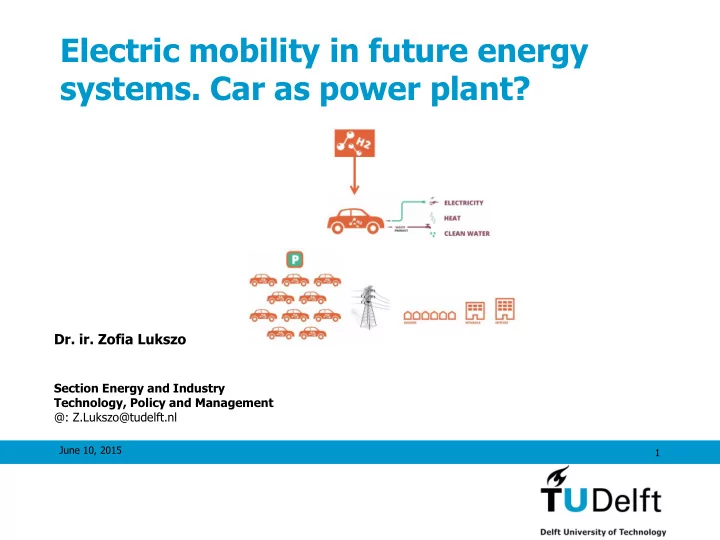

Electric mobility in future energy systems. Car as power plant? Dr. ir. Zofia Lukszo Section Energy and Industry Technology, Policy and Management @: Z.Lukszo@tudelft.nl June 10, 2015 1
Content • Variability in future energy systems • Electric mobility and responsive demand • Are the goals of many actors involved the same? • Why EVs can be compared to cold storage warehouses? • What can we learn from looking at different price scenario’s? • Car as Power Plant June 10, 2015 2
Future energy systems Old New schedule generation schedule demand to meet demand to meet generation e.g. electric mobility
Future energy systems Old New schedule generation schedule demand to meet demand to meet generation DSM - e.g. electric mobility
Future energy systems • From “scheduling the generation to meet demand” to “everything interacts with everything” • Increased real-time balancing • Introduction of aggregators
Variability vs. Flexibility From: Holttinen, H., et.al., The Flexibility Workout: Managing Variable Resources and Assessing the Need for Power System Modification, IEEE Power and Energy Magazine, 11(6), 2013
The impact of variable generation From: Holttinen, H., et.al., The Flexibility Workout: Managing Variable Resources and Assessing the Need for Power System Modification, IEEE Power and Energy Magazine, 11(6), 2013
Our approach The world in “layers”: • institutions: laws and regulations • actors (social networks) • physical networks • Strong Complex Adaptive Systems perspective • Socio-technical complexity Evolution / coevolution / dynamics Multi level / Multi actors / Multi criteria / Multi time scale Multidisciplinary teams • combinations of different methods/theories • Mathematical modeling, optimization and control Socio-technical ABM of systems evolution and operation Gaming Network theory / topology … out of the box thinking, e.g. are theoretically expected situations • achieved?: If not, then what? Empiricism: How do the different countries operate? •
Power sector complex socio-technical system
Demand side - Electric mobility How can electric mobility contribute to a more sustainable transportation & electrical power system and on the same time align the interests of its relevant actors? See: Remco Verzijlbergh , The Power of Electric Vehicles, PhD Thesis TU Delft, 2013, http://repository.tudelft.nl/
Energy usage households +/- 10 kWh 7 6 5 4 3 2 1 0 Energy demand (kWh/day)
Standard Household Profile
Estimation of the expected energy usage of EVs Data from Mobility Research Netherlands Average: ~34 km ~ 90% < 100km Ministry of Transport, Public Works and Water Management, “Mobiliteitsonderzoek Nederland (in Dutch)” Available: www.mobiliteitsonderzoeknederland.nl
Charging scenario's and network load Based on real life data
Network load:100 houses and 50 EVs Price control Load Control Imbalance Control June 10, 2015 15 Separate EV demand profiles
Charging strategy based on predicted price June 10, 2015 16
Negative price? Conventional, wind and solar power and spot prices for the German system on June 16th 2013.
Demand side – cold storage Old New schedule generation schedule demand to meet demand to meet generation e.g. with a cold storage warehouse
Matching renewable energy and demand response through price System model: Cold store has PV generation on site • PV production known in advance • Pays price C in (t) for energy, receives C out (t) • Temperature upper bound T max • Goal: Investigate relations between demand response strategy of a cold store and electricity prices & Evaluate different pricing regimes on optimal energy use
Physical model of cold store Heat balance Incoming heat Outgoing heat Resulting equation for T dynamics Discretized in time
Optimization formulation Objective function constraints
Compare cold store with EV optimization problem Optimization problem State dynamics
Price scenarios A: flat tariff B: flat double tariff C: day-night tariff D: APX based real time tariff E: APX based real time tariff, high solar penetration
Comparison • Optimal cooling trajectory depends strongly on tariff structure. • Local use of PV energy depends on tariffs • Most 'value' of control in case with high solar penetration. • The effective use of demand response requires the right tariff structure
How to define effective use of the demand response? TIP
Electric cars – disadvantages June 10, 2015 26 Ad van Wijk & Leendert Verhoef, Our Car as Power Plant, Delft, 2014.
Fuel cell cars converts the chem. energy of a fuel (hydrogen) directly to electricity June 10, 2015 27
Hydrogen production technology June 10, 2015 28
Efficiency cars June 10, 2015 29
Power plants and car power capacity June 10, 2015 30
Transport and Electricity system – expected changes June 10, 2015 31
Reasons to believe June 10, 2015 32
How to organize such a system? • A wide variety of new products, services and systems to come, but who will deliver this? • The cars need to be integrated in the larger energy and transport system. These challenges are on all system levels: from individual cars, to car parks, houses, offices, neighbourhoods, cities and regions. June 10, 2015 33
Exploring the emergence of the Car as Power Plant with a socio-technical TIP design perspective
June 10, 35 2015
Agent-Based Model (ABM) for TIP design Physical Network Actor Network Physical Network Actor Network Infrastructure Interaction agent agent tech. tech. Koen H. van Dam, Igor Nikolic and Zofia Lukszo (Eds.), Agent-based modelling of socio-technical systems , 275 p., Springer, 2013
ABM components • Agents • States • Decision rules • Actions • Environment • Time
Simulating Energy Transitions. Emile Chappin, 2011, Delft University of Technology, the Netherlands. Thesis, 2011. ISBN: 9789079787302
Modeling of energy infrastructures: ABM and TIP • help to reduce uncertainty for actors in the energy chain by developing tools that are needed for smart energy systems June 10, 2015
June 10, 40 2015
Recommend
More recommend